

Learn. David Haglund on Twitter: "What Did Haglund Learn Today? is out! Stories via @petercook @onlinelearningI @ThomasSealock" What’s next: Blended Learning 2.0. PROVIDENCE, R.I. — Rhode Island is fertile ground for experimentation with technology in classrooms as it seeks to the first fully blended learning state in the nation.
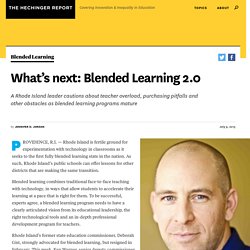
As such, Rhode Island’s public schools can offer lessons for other districts that are making the same transition. Blended learning combines traditional face-to-face teaching with technology, in ways that allow students to accelerate their learning at a pace that is right for them. To be successful, experts agree, a blended learning program needs to have a clearly articulated vision from its educational leadership, the right technological tools and an in-depth professional development program for teachers.
Rhode Island’s former state education commissioner, Deborah Gist, strongly advocated for blended learning, but resigned in February. This week, Ken Wagner, senior deputy commissioner in the New York State Department of Education, was named to replace her (pending a vote of the Board of Education). TLA_CommsPlanningForBL_FIN.pdf. Glued to the screen: A third grade class where kids spend 75% of the day on iPads. MINEOLA, N.Y. — When the 24 third-graders in Morgan Mercaldi’s class arrive at the Jackson Avenue School every morning, they take their iPads out of their backpacks and put them on their desks.

The tablets will remain there, or in hands and laps, until the children put them in their packs to take them home. Last year Mercaldi had her students stash the iPads away when they weren’t using them. But she has abandoned that. Edsurge. At Cristo Rey San Jose Jesuit High School in San Jose, CA, students are experiencing a new style of learning.
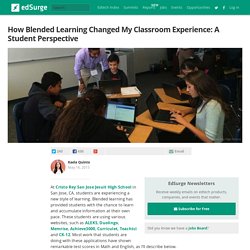
Blended learning has provided students with the chance to learn and accumulate information at their own pace. These students are using various websites, such as ALEKS, Duolingo, Memrise, Achieve3000, Curriculet, Teachtci and CK-12. Most work that students are doing with these applications have shown remarkable test scores in Math and English, as I’ll describe below. But is blended learning the real reason for the increase in scores? Blended Learning: 3 Stories of Success. Many educators and school leaders are ready to move from the “why” do blended learning to the “how” to do blended learning.
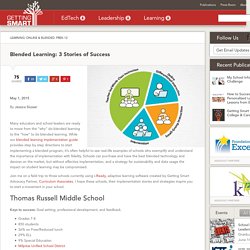
While our blended learning implementation guide provides step by step directions to start implementing a blended program, it’s often helpful to see real-life examples of schools who exemplify and understand the importance of implementation with fidelity. Schools can purchase and have the best blended technology and devices on the market, but without effective implementation, and a strategy for sustainability and data usage the impact on student learning may be compromised.
Join me on a field trip to three schools currently using i-Ready, adaptive learning software created by Getting Smart Advocacy Partner, Curriculum Associates. I hope these schools, their implementation stories and strategies inspire you to start a movement in your school. Keys to success: Goal setting; professional development; and feedback.
When the Computer Takes Over for the Teacher — The Atlantic. Whenever a college student asks me, a veteran high-school English educator, about the prospects of becoming a public-school teacher, I never think it’s enough to say that the role is shifting from "content expert" to "curriculum facilitator.
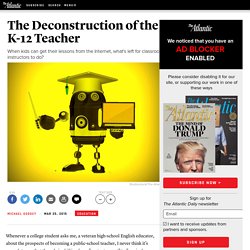
" Instead, I describe what I think the public-school classroom will look like in 20 years, with a large, fantastic computer screen at the front, streaming one of the nation’s most engaging, informative lessons available on a particular topic. The "virtual class" will be introduced, guided, and curated by one of the country’s best teachers (a.k.a. a "super-teacher"), and it will include professionally produced footage of current events, relevant excerpts from powerful TedTalks, interactive games students can play against other students nationwide, and a formal assessment that the computer will immediately score and record.
"So if you want to be a teacher," I tell the college student, "you better be a super-teacher. " I started reflecting. True tech integration starts with learning goals. Silicon Schools Fund and Clayton Christensen Institute. 50 Ways EdTech Benefits Teachers and Students. There are at least 50 ways new tools are helping teachers to create new learning environments and experiences for students.

BYOD brings its own challenges for schools and students. Arrived: The bring your own device trend has landed in Australian schools but educators are still watching what it will mean for learning.
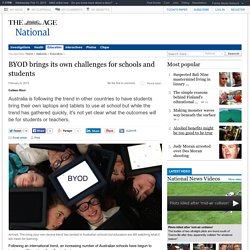
Following an international trend, an increasing number of Australian schools have begun to implement "Bring Your Own Device" schemes. What is happening? "Bring your own device" (BYOD) refers to a technology model that allows students to bring their own devices to school for learning in the classroom. The term "BYOD" was first coined in the corporate world a few years ago, with companies allowing employees to use their personal laptop computers, smart phones, tablets and other mobile devices in the workplace.
However, it has since gained traction in the education sector with an increasing number of schools around the world choosing to implement their own BYOD policies. Lessons From the Frontier: How to Make Blended Learning Truly Work. EdSurge Newsletters Receive weekly emails on edtech products, companies, and events that matter.

Three false dichotomies in blended learning. With the rise of blended learning, skeptics are quick to point out why children may miss out if some of their learning happens in front of a computer.
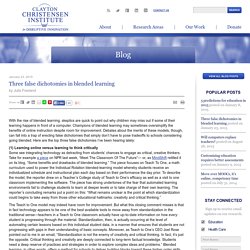
Champions of blended learning may sometimes oversimplify the benefits of online instruction despite room for improvement. The Backchannel: Giving Every Student a Voice in the Blended Mobile Classroom. A backchannel -- a digital conversation that runs concurrently with a face-to-face activity -- provides students with an outlet to engage in conversation.
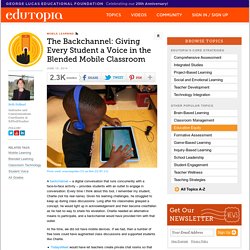
Every time I think about this tool, I remember my student, Charlie (not his real name). Given his learning challenges, he struggled to keep up during class discussions. A virtual analysis. A new analysis of four blended-format courses taught last fall offers practical guidance for faculty members interested in fresh pedagogical approaches. The pilot study led by the Bok Center for Teaching and Learning and released today after months of checks and balances showed that students responded most to lesson structure and execution, placed a premium on person-to-person interaction, and found redundancies between in-class and online instruction.
A related report from the Harvard Graduate School of Education (GSE) that focused on a single undergraduate history course also covered in the Bok study had similar findings. The Bok study analyzed student responses to four undergraduate General Education courses taught in the fall of 2013 that integrated online components into the classroom: “The Einstein Revolution,” “Concepts of the Hero in Classical Greek Civilization,” “China,” and “Science and Cooking.” E-Learning Strategies Symposium - Smart Series. The Digital Learning Now! Smart Series is a collection of interactive papers that provide specific guidance for policy makers and education leaders regarding the adoption of the Common Core State Standards and the shift to personal digital learning. The recently released ebook, “Navigating the Digital Shift” offers updated versions of the papers originally released in the DLN Smart Series including contributions from 11 authors representing leading organizations such as Public Impact, the International Association for K-12 Online Learning (iNACOL), CompetencyWorks and The Learning Accelerator.
Featured Paper: Smart Series Guide to EdTech Procurement Release Date – January 15, 2014 Download:Paper – PDFPaper – Print VersionExecutive SummaryInfographic: Smart EdTech Requires Buying Smart – Download. Innosight Institute. 7 Things You Should Know About the HyFlex Course Model.